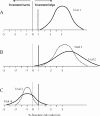Tips for learners of evidence-based medicine: 2. Measures of precision (confidence intervals)
- PMID: 15367466
- PMCID: PMC516199
- DOI: 10.1503/cmaj.1031667
Tips for learners of evidence-based medicine: 2. Measures of precision (confidence intervals)
Erratum in
- CMAJ. 2005 Jan 18;172(2):162
Figures


Similar articles
-
Tips for learners of evidence-based medicine: 4. Assessing heterogeneity of primary studies in systematic reviews and whether to combine their results.CMAJ. 2005 Mar 1;172(5):661-5. doi: 10.1503/cmaj.1031920. CMAJ. 2005. PMID: 15738493 Free PMC article. Review. No abstract available.
-
The evidence provided by a single trial is less reliable than its statistical analysis suggests.J Clin Epidemiol. 2009 Jul;62(7):711-715.e1. doi: 10.1016/j.jclinepi.2008.09.013. Epub 2009 Jan 25. J Clin Epidemiol. 2009. PMID: 19171462
-
Confidence intervals for a ratio of two independent binomial proportions.Stat Med. 2008 Nov 20;27(26):5497-508. doi: 10.1002/sim.3376. Stat Med. 2008. PMID: 18781560
-
Tips for learners of evidence-based medicine: 3. Measures of observer variability (kappa statistic).CMAJ. 2004 Nov 23;171(11):1369-73. doi: 10.1503/cmaj.1031981. CMAJ. 2004. PMID: 15557592 Free PMC article. No abstract available.
-
Evaluation of the evidence.Vet Clin North Am Small Anim Pract. 2007 May;37(3):447-62. doi: 10.1016/j.cvsm.2007.01.004. Vet Clin North Am Small Anim Pract. 2007. PMID: 17466749 Review.
Cited by
-
What every urologist should know about surgical trials Part II: What are the results and should I apply them to patient care?Indian J Urol. 2008 Oct;24(4):437-43. doi: 10.4103/0970-1591.44245. Indian J Urol. 2008. PMID: 19468493 Free PMC article.
-
Surgical outcomes research based on administrative data: inferior or complementary to prospective randomized clinical trials?World J Surg. 2006 Mar;30(3):255-66. doi: 10.1007/s00268-005-0156-0. World J Surg. 2006. PMID: 16485067
-
Challenging orthodoxy in critical care trial design: physiological responsiveness.Ann Transl Med. 2016 Apr;4(7):147. doi: 10.21037/atm.2016.03.45. Ann Transl Med. 2016. PMID: 27162797 Free PMC article. No abstract available.
-
Validation of the modified Fresno test: assessing physical therapists' evidence based practice knowledge and skills.BMC Med Educ. 2010 May 25;10:38. doi: 10.1186/1472-6920-10-38. BMC Med Educ. 2010. PMID: 20500871 Free PMC article.
-
Users' Guide to the Surgical Literature. Understanding confidence intervals.Can J Surg. 2012 Jun;55(3):207-11. doi: 10.1503/cjs.010211. Can J Surg. 2012. PMID: 22630064 Free PMC article. No abstract available.
References
-
- Guyatt G, Jaeschke R, Cook D, Walter S. Therapy and understanding the results: hypothesis testing. In: Guyatt G, Rennie D, editors. Users' guides to the medical literature: a manual of evidence-based clinical practice. Chicago: AMA Press; 2002. p. 329-38.
-
- Guyatt G, Walter S, Cook D, Jaeschke R. Therapy and understanding the results: confidence intervals. In: Guyatt G, Rennie D, editors. Users' guides to the medical literature: a manual of evidence-based clinical practice. Chicago: AMA Press; 2002. p. 339-49.
-
- Guyatt G, Montori V, Devereaux PJ, Schunemann H, Bhandari M. Patients at the center: in our practice, and in our use of language. ACP J Club 2004; 140: A11-2. - PubMed
MeSH terms
LinkOut - more resources
Full Text Sources
